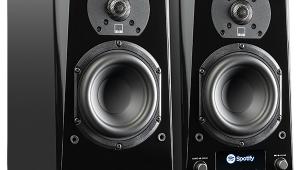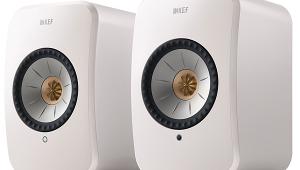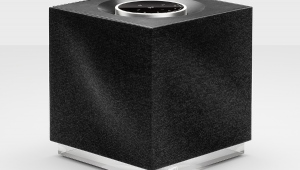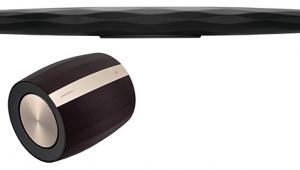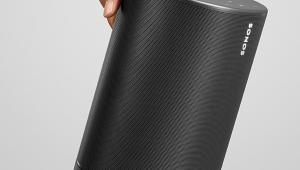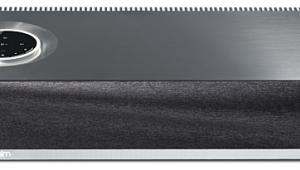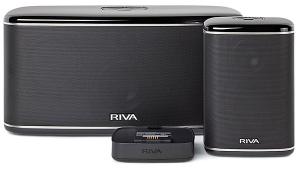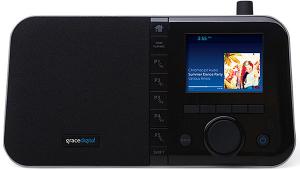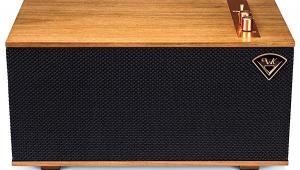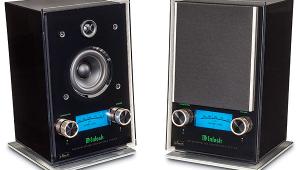Review: Dynaudio Xeo 5 wireless speakers Page 3
Measurements and Extended Lab Notes
Frequency response
37 Hz to 20 kHz ±3.7 dB on-axis, ±5.9 dB avg 0°-30°
Bass output (CEA-2010A standard)
• Ultra-low bass (20-31.5 Hz) average: 91.7 dB
20 Hz 72.3 dB
25 Hz 84.5 dB
31.5 Hz 99.5 dB
• Low bass (40-63 Hz) average: 108.2 dB
40 Hz 106.0 dB L
50 Hz 107.6 dB L
63Hz 110.4 dB L
To measure the Xeo 5’s quasi-anechoic frequency response, I set it atop my measurement turntable and placed the microphone at a distance of 2 meters. (Quasi-anechoic measurements eliminate reflections from surrounding objects to simulate measuring in an anechoic chamber.) The microphone was placed on the same axis as the tweeter. I ran a ground-plane measurement at 1 meter to get the bass response. The curves in the graph here shows the bass response spliced at 200 Hz to the 0° on-axis measurement and the average of quasi-anechoic measurements taken at 0°, ±10°, ±20°, and ±30°. I used a Clio FW analyzer in MLS mode for the quasi-anechoic measurements and log chirp mode for ground plane, feeding test signals into the left-channel RCA input of the Xeo’s wireless interface. The quasi-anechoic measurements were smoothed to 1/12th octave. The blue trace shows the 0° on-axis response, while the green trace shows the averaged response.
The primary characteristics of the Xeo 5’s measurements are a generally flat response with a mildly downward-tilted treble response. Unusually, there’s a dip of about -4 dB in the on-axis response at 3.7 kHz, but the dip fills in almost completely as you move to 30° off-axis. Also, the tweeter’s response rolls off some above 10 kHz on-axis, but off-axis, at 20° or 30°, it drops abruptly above that frequency. The anomaly at 3.7 kHz is unlikely to be audible, but the treble roll-off almost certainly will be. I couldn’t measure sensitivity or impedance because the Xeo 5 is an internally amplified system.
CEA-2010 output measurements for the Xeo 5 were taken at 1 meter to maximize the signal-to-noise ratio of the measurements. (Normally CEA-2010A is taken at 3 meters, but that technique doesn’t work well with speakers and subs that have relatively modest output at low frequencies.) Measurements with an L next to them are those in which the maximum output was determined by the Xeo 5’s internal limiter. Averages are calculated in pascals.
I’m impressed with the bass output of the Xeo 5, especially considering its small form factor. Plus, you’ll get roughly +6 dB more output when you add a second Xeo 5. At an average of 108.2 dB from 40 to 63 Hz, output is comparable to that of a typical inexpensive 8-inch subwoofer, and unlike most 8-inch subs, the Xeo 5 actually delivers measurable response down to 20 Hz (although just barely). — Brent Butterworth
Bottom Line
Xeo is like a high-end iPod for your living room, which doubtless was the design concept. There’s nothing not to like except the price. Dynaudio gear has always been expensive, and in that context the Xeo 5’s $4,500 price tag, while high, is not unexpected — and, of course, you must de-factor the cost of amplifier or preamp. It’s still a lot of coin, but these are not dorm-room speakers. Thank God for that: Xeo is far too good to waste on kids.
